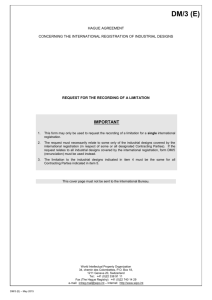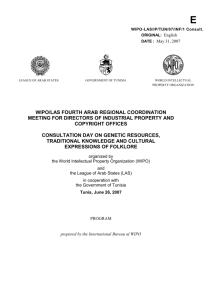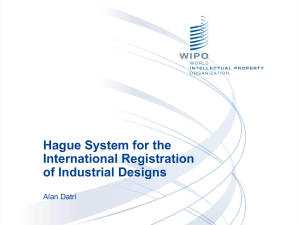The Origins and Basic Principles of the Hague System
advertisement
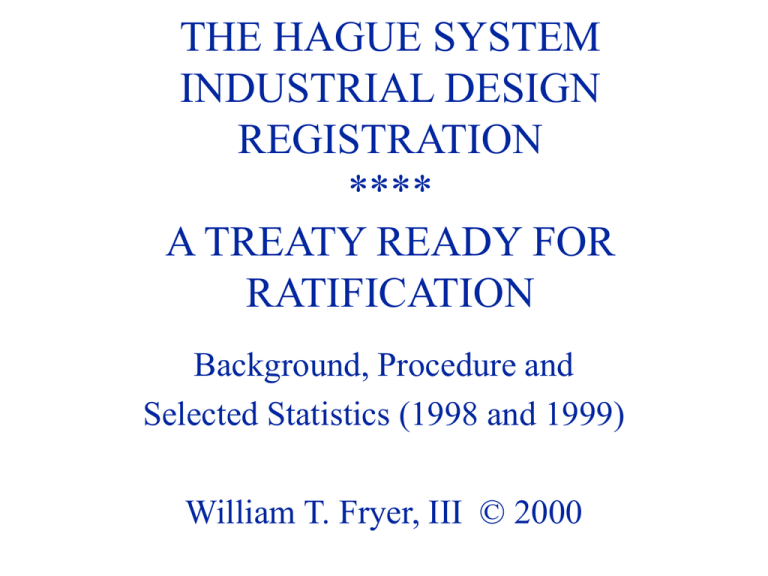
THE HAGUE SYSTEM INDUSTRIAL DESIGN REGISTRATION **** A TREATY READY FOR RATIFICATION Background, Procedure and Selected Statistics (1998 and 1999) William T. Fryer, III © 2000 This presentation was adapted and supplemented from a 1999 paper presented in French by Mr. Gregoire Bisson, Head of the Industrial Design Registry, World Intellectual Property Organization (WIPO) The presentation can be downloaded, copied and displayed for non-commercial purposes, with credit given to William T. Fryer III and the copyright notice displayed. HISTORY OF THE HAGUE AGREEMENT CONCERNING THE INTERNATIONAL DEPOSIT OF INDUSTRIAL DESIGNS • Adopted in 1925 and entered into force in June 1928 • The initial members were: Germany, Spain, France and Switzerland. • The 1925 Act was not very active. • Major revisions occurred in 1934 and 1960. • The 1960 Act is the version most widely used now. HAGUE AGREEMENT HISTORY (continued) • A Geneva Act of the Hague Agreement was approved in 1999. It is this Act that is up for ratification in the U. S. THE 1934 ACT • Entered into force in June 1939 • Member States (16): Benin, Ivory Coast, Egypt, Spain, France, Germany, Hungary, Indonesia, Liechtenstein, Morocco, Monaco, Holy See, Senegal, Suriname, Switzerland, and Tunisia. (Countries in blue or underlined are equally parties to the 1960 Act; Netherland Antilles effect only under 1934 Act) THE 1934 ACT PROCEDURE • French language only • More than one design in several classes can be filed in an application • Registration has effect in all members, except the country of origin • Publication of registration information • Duration is 5 years or 15 years THE 1960 ACT • Entered into force in August 1984 • Currently 24 members: Belgium, Benin, Bulgaria, Ivory Coast, Germany, Democratic People ’s Republic of Korea, France, Greece, Hungary, Italy, Liechtenstein, Luxembourg, Monaco, Mongolia, Morocco, The Netherlands, Republic of Moldova, Romania, Senegal, Slovenia, Suriname, Switzerland, Republic of Macedonia, and Yugoslovia. (The countries in blue or underlined are equally parties to the 1934 Act.) 1960 ACT PROCEDURE • • • • • File directly with WIPO In French or English File design reproduction 100 designs in the same class maximum Designate the State, including country of origin, unless contrary to national law • Review by WIPO on formalities accepted by contracting parties 1960 ACT PROCEDURE (Continued) • 12 month publication deferment (roughly 10% of the applications requested in 1999) • Publication of design on CD-ROM • Protection under national law • Effective for 5 years and renewable at least one time for 5 years more THE 1999 ACT • Treaty approved July 2, 1999 • Many countries and inter-governmental organizations signed this treaty, including the U.S.A. At the close of the period for signature, 29 countries has signed. • The treaty is in the process of acquiring members, in order to come into force. THE 1999 ACT PROCEDURES • FILING WITH NATIONAL OFFICE OR WIPO • DEFERED PUBLICATION UP TO EACH MEMBER • EXAMINATION FOR NOVELTY ACCOMMODATED THE 1999 ACT ADVANTAGES • Affordable filing costs, with up to 100 designs from one class maximum • In many countries the filing cost is all that is paid to obtain a registration. • Centralized filing, processed by WIPO • Prompt WIPO processing - usually registration published in 6 months from WIPO filing date 1999 ACT ADVANTAGES (Continued) • Internet access for applicant filing and searching, and for national office and WIPO communications are planned. • Application for all countries on one form and in English or French • Filing with WIPO by design owner or representative • Communications with WIPO in English 1998 STATISTICS • Number of Deposits ----------------------------------------- 3,970 • Designs Contained in Deposits -------------------------- 18,921 • Average Number of Designs in Each Application --------- 4.8 • Average Number of States Designated ---------------------- 11 • Average Cost for Deposit --------------------------- 1400 CHF • Estimated Average Cost per country ------------------- $ US 76 • Estimated Average Cost per Country/per Design ----- $ US 15 (U.S. dollar computation was based on approximate exchange rate on June 12, 2000; calculation was based on designating 11 countries and 4 designs.) 1999 STATISTICS Number of Deposits (3% increase from 1998) -------------------------------------------- 4,093 • • Designs Contained in Deposits (4.4 % increase from 1998) ------------------- 19,763 • Average Number of Designs in Each Application (1998 same) ------------------- 4.8 • Average Number of States Designate (1998 same) ---------------------------------------- 11 DISTRIBUTION OF REGISTRATIONS BASED ON COUNTRY OF ORIGIN - 1998 Registered deposits by country of the owner for 1998 Countries Greece BENELUX ESPAGNE FRANCE ITALIE SUISSE Autres Number of deposits 1156 575 179 SWITZERLAND 1003 14% 456 556 45 OTHER 1% GERMANY 30% ITALY 11% FRANCE 25% SPAIN 5% BENELUX 14% DESIGNATIONS IN 1998 FR 7% Autres 22% DE 7% BX 7% MC 2% IT 7% LI 2% HU 2% CH 6% GR 2% VA 5% ID 5% EG 5% TN 5% MA 5% AN 5% ES 5% DEPOSITS ACCORDING TO CLASSES IN 1998 cl.2 5% cl.6 12% Others 25% cl.7 7% cl.8 5% cl.26 4% cl.23 5% cl.19 4% cl.9 10% cl.14 5% cl.12 5% cl.11 5% cl.10 8% DESIGNATIONS ACCORDING TO CLASSES IN 1998 cl.2 4% Autres 15% cl.25 3% cl.6 10% cl.26 4% cl.7 7% cl.8 5% cl.23 5% cl.21 3% cl.20 3% cl.9 10% cl.19 4% cl.14 5% cl.12 5% cl.11 5% cl.10 12% 1999 MOST POPULAR CLASSES • • • • • • Class 6 --- Furniture Class 7 --- Household Goods Class 9 --- Packages and Containers Class 10 --- Watches and Clocks Class 12 -- Means of Transportation …. Class 23 -- Heating, Ventilation and Air Conditioning Equipment CONCLUSIONS • The Hague 1999 Act on industrial design registration combines a number of popular, cost cutting features from its prior acts. • The 1999 Act accommodates novelty examination countries. • The Internet implementation of the 1999 Act will facilitate efficient use. • Global membership of the 1999 Act is expected. END
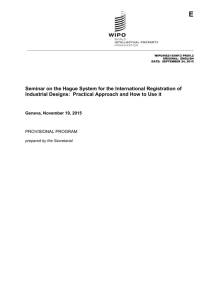
![Invitation [word format]](http://s3.studylib.net/store/data/007096478_1-54334bf5ab877bf1ebd233e686a3f8bb-300x300.png)

